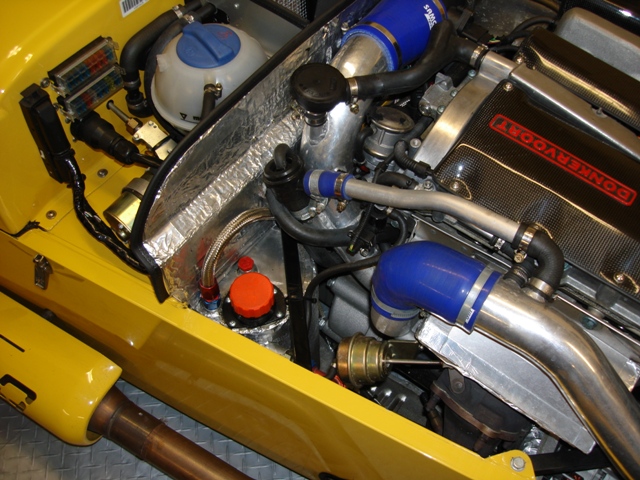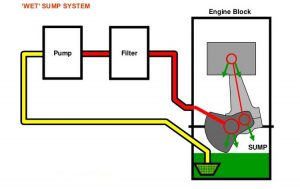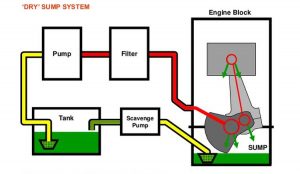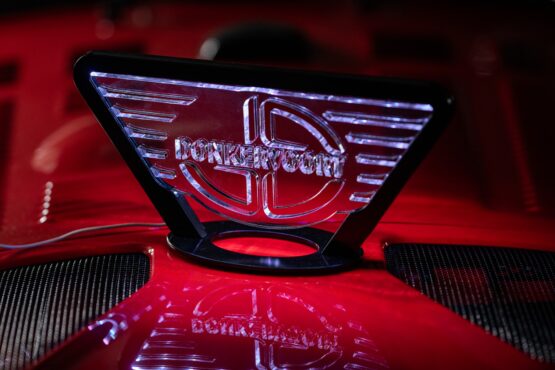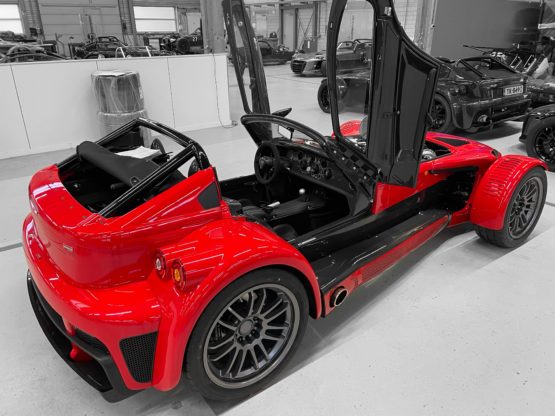The Donkervoort D8 with 1.8 20V turbo engine (D8 AGU and D8-egas) dry sump lubrication system is the ultimate oiling system compared to the regular engine sump lubrication system. The simple fact that all Formula One, Indy cars, Le Mans and Sports Racing cars use dry sumps, proves this point. The first dry sump systems mounted on the D8 came from the German Donkervoort importer, Michael Düchting. The systems are manufactured in Switzerland.
In order to have a good understanding of the dry sump system, let’s first examine the wet sump system. Wet sump oiling systems are used on 99% of all street cars. They utilize a conventional oil pan with dipstick, where the oil is stored and supplied to the oil pump. The oil is sucked up a pickup tube into the stock oil pump, where it is filtered and supplied to the engine under pressure. While this system is very adequate for highway use, it presents problems under racing conditions. Aside from the size of the pan, and necessity of a deep sump, the oil is subjected to extreme cornering forces in racing, and the oil simply “crawls” up the sides of the pan and away from the pick-up. Although there are many good designs, with trap doors, etc., racing cars generate lateral and acceleration/deceleration forces that overcome the best wet sump designs. Aside from the obvious pressure loss, this also results in a reduction in horsepower as well as oil aeration.
These are the reasons dry sumps were developed. I will discuss other advantages later. The main purpose of the dry sump system is to contain all the stored oil in a separate tank, or reservoir. This reservoir is usually tall and round or narrow and specially designed with internal baffles, and an oil outlet (supply) at the very bottom for uninhibited oil supply. The dry sump oil pump is a minimum of 2 stages, with as many as 5 or 6. One stage is for pressure and is supplied the oil from the bottom of the reservoir, and along with an adjustable pressure regulator, supplies the oil under pressure through the filter and into the engine. The remaining stages “scavenge” the oil out of the dry sump pan and return the oil (and air) to the top of the tank or reservoir. If an oil cooler is used usually it is mounted inline between the scavenge outlets and the tank. The dry sump pump is driven by a timing belt and pulleys, off the front of the crankshaft, at approximately one half crank speed. The dry sump pump is designed with multiple stages, to insure that all the oil is scavenged from the pan. This also results in removing excess air from the crankcase, and is the reason they are called “dry sump” meaning the oil pan is essentially dry. Increased engine reliability from the consistent oil pressure provided by the dry sump system is the reason dry sumps were invented. The many other benefits I mentioned earlier are, shallower oil pan allowing engine to be lowered in chassis, horsepower increase due to less viscous drag (oil resistance due to sloshing into rotating assembly) and cooler oil.
We have also increased these advantages further through advanced designs of windage trays, and scavenge pickup designs and locations, as well as our utilization of precision machined alloy castings, which add stiffness to the block and afford better sealing. All in all, the dry sump system came out of necessity to maintain oil pressure, and evolved into a very sophisticated system which increases reliability as well as horsepower while allowing the engines to be mounted with the lowest center of gravity.
The dry sump oil container has an engine oil capacity of around 8 liters. Note: The rubber drive belt needs to be replaced annually. Further info here. The only disadvantage of a D8 with dry sump lubrication is that it has a more cramped passenger side leg room, because 50% of the oil reservoir is mounted in the passenger compartment. And it takes a little longer to get the right temperature in your engine oil after a cold start. You have to drive around 20 kilometers before you can really lower your throttle pedal and rev up the engine.
Unfortunately the D8 GTO does not have an option for a dry sump system (yet).

